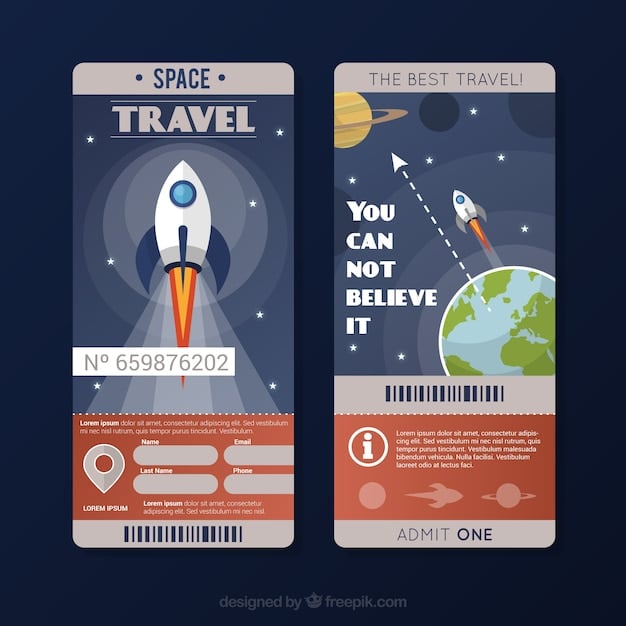Space Tourism: Is It Affordable for the Average US Citizen?

Space tourism remains a distant dream for most US citizens, with current prices far exceeding the average budget, but technological advancements and increasing competition may eventually make it more accessible.
Dreaming of soaring through the stars? **Space tourism: When will it be accessible to the average US citizen?** This question lingers in the minds of many as we watch billionaires venture into the cosmos. Let’s explore the current state of space tourism, the factors influencing its cost, and when it might become a reality for more than just the ultra-rich.
The Current Landscape of Space Tourism
The reality of space tourism today? It’s exclusive. Currently, only a handful of companies offer space flights, and the price tags are astronomical. This section will explore the players in the space tourism industry and the costs associated with their services.
Key Players in Space Tourism
Several companies are leading the charge in making space tourism a reality. Here are a few notable ones:
- Virgin Galactic: Focusing on suborbital flights, offering a brief experience of weightlessness and stunning views of Earth.
- Blue Origin: Also offering suborbital flights with their New Shepard rocket, aiming for a similar experience to Virgin Galactic.
- SpaceX: Taking a different approach with orbital flights and even plans for lunar and Martian missions, offering a more extended and immersive space experience.
The Price of a Ticket to Space
For those who can afford it, the experience is truly out of this world. However, the biggest barrier to entry is undoubtedly the cost.
- Virgin Galactic: Tickets for a suborbital flight currently cost around $450,000 per person.
- Blue Origin: While they haven’t publicly disclosed prices, estimates place them in a similar range to Virgin Galactic.
- SpaceX: The price for a multi-day orbital mission with SpaceX can reach tens of millions of dollars.

The current space tourism market is geared towards high-net-worth individuals, making it inaccessible to the average US citizen. The high costs are due to technological complexities, research and development expenses, and the limited number of flights available.
Factors Influencing the Cost of Space Tourism
Many factors contribute to the high cost of space tourism. Understanding these influences is crucial to predicting when prices might drop to a more accessible level.
Technological Advancements
Advancements in rocketry and spacecraft technology are key to reducing costs. Reusable rockets, for example, can significantly lower the expense of each flight.
Competition Among Providers
As more companies enter the space tourism market, competition will likely drive down prices. Increased competition encourages innovation and efficiency, leading to lower costs for consumers.
Economies of Scale
As the volume of space flights increases, the industry can achieve economies of scale. More frequent flights and higher passenger numbers can distribute costs more efficiently, leading to lower prices per ticket.
Government Regulations and Support
Government regulations and support can also play a role in the affordability of space tourism. Streamlined regulations and government investment in space technology can help reduce costs and encourage innovation.
Ultimately, technological advancements, increased competition, economies of scale, and supportive government policies will drive down the cost of space tourism, making it more accessible to the average US citizen.
Potential Future Price Reductions
Predicting the future of space tourism pricing is challenging, but several factors suggest that prices will eventually decrease. This section will make some educated guesses, based on current trends in technology and business.
The Impact of Reusable Rockets
Reusable rockets, pioneered by companies like SpaceX, are a game-changer in the space industry. By reusing rockets, the cost of each launch is significantly reduced.
This technology is still relatively new, but as it matures and becomes more widely adopted, the cost savings will be passed on to consumers.
Projected Cost Declines Over Time
- Short-Term (5-10 years): Suborbital flights could potentially drop to $100,000 – $200,000 per person.
- Mid-Term (10-20 years): Orbital flights might become accessible for around $500,000 per person.
- Long-Term (20+ years): With significant technological breakthroughs and increased competition, space tourism could become as affordable as a luxury cruise, perhaps in the tens of thousands of dollars.

These are, of course, just projections. The actual timeline and price reductions will depend on various factors, including technological progress, market demand, and the overall economic climate. However, the trend is clear: space tourism is likely to become more affordable over time.
Alternative Space Experiences
While a trip to space remains out of reach for most, several alternative experiences offer a taste of space exploration. These alternatives can provide a glimpse into the wonders of space without breaking the bank.
Simulated Space Flights
Many space museums and science centers offer simulated space flights. These simulations use advanced technology to create a realistic experience of space travel.
Zero-Gravity Flights on Earth
Companies like Zero Gravity Corporation offer parabolic flights that create brief periods of weightlessness. While not technically space travel, these flights provide a similar sensation to being in space.
Virtual Reality Space Experiences
Virtual reality (VR) technology is rapidly advancing, offering immersive space experiences from the comfort of your home. VR headsets can transport you to distant planets and galaxies, providing a captivating and educational experience.
These alternative experiences can be a great way to satisfy your curiosity about space while waiting for space tourism to become more affordable. They also offer valuable educational opportunities and inspire a passion for space exploration.
The Ethical Considerations of Space Tourism
As space tourism becomes more prevalent, it’s important to consider its ethical implications. This section will lay out some of the potential concerns around environmental impacts. How big is the carbon footprint? Is it safe?
Environmental Impact
The environmental impact of space tourism is a growing concern. Rocket launches release pollutants into the atmosphere, contributing to climate change. The long-term effects of these emissions on the ozone layer and global climate need to be carefully studied.
- Investing in sustainable propulsion systems.
- Minimizing the frequency of launches.
- Offsetting carbon emissions through reforestation and other environmental initiatives.
Safety Concerns
Space travel is inherently risky. While space tourism companies prioritize safety, accidents can happen. Passengers on space flights need to be aware of the potential dangers and be prepared for emergencies.
- Stringent safety regulations and oversight.
- Thorough pre-flight training and medical screening for passengers.
- Investing in advanced safety systems and emergency response protocols.
Addressing these ethical considerations is essential to ensure that space tourism develops in a responsible and sustainable manner. By mitigating the environmental impact and prioritizing safety, we can make space travel a truly positive experience for everyone.
When Will Space Tourism Be Accessible to the Average US Citizen?
So, the million-dollar question (or rather, the half-million-dollar question): When will space tourism be accessible to the average US citizen? The answer is complex and depends on a variety of factors, as well as what “average” actually means.
Defining “Average”
Defining “average US citizen” is tricky. According to the US Census Bureau, the median household income in the United States in 2022 was $74,580. Obviously, spending hundreds of thousands of dollars on a space trip is not a realistic option for someone in that income bracket.
A Realistic Timeline
Based on current trends and projections, here’s a possible timeline:
- Within 20 years: It’s conceivable that suborbital flights could become accessible to the upper-middle class, with costs in the tens of thousands of dollars.
- In the more distant future: If technological advancements continue at a rapid pace, space tourism could eventually become as affordable as a luxury vacation for a wider segment of the population.
It’s important to remember that these are just predictions. The actual timeline will depend on various factors, including technological breakthroughs, economic conditions, and the level of competition in the space tourism industry.
| Key Point | Brief Description |
|---|---|
| 🚀 High Costs | Current space tourism prices are prohibitive for average citizens. |
| 💰 Influencing Factors | Tech advancements, competition, and economies of scale can reduce prices. |
| ⏱️ Realistic Timeline | Accessibility for the upper-middle class could be within 20 years. |
| 🌍 Ethical Concerns | Environmental impact and safety are critical considerations for sustainable development. |
Frequently Asked Questions
▼
Currently, space tourism flights can range from $450,000 for suborbital flights with Virgin Galactic to tens of millions for orbital missions with SpaceX, placing it far beyond the reach of the average US citizen.
▼
Technological advancements like reusable rockets, increased competition among providers, and economies of scale in the space flight industry are all factors that could drive down the cost of space tourism.
▼
Yes, alternatives include simulated space flights at museums, zero-gravity flights on Earth, and immersive virtual reality space explorations, offering a taste of space without the high price tag of actual space travel.
▼
Ethical considerations include the environmental impact of rocket launches, particularly their contribution to climate change, and safety concerns for passengers, necessitating sustainable practices and stringent safety regulations.
▼
While it’s hard to say for sure, suborbital flights could become accessible to the upper-middle class within 20 years, with costs potentially in the tens of thousands of dollars if technology continues to advance.
Conclusion
While space tourism remains a distant dream for most Americans, the future holds promise. With ongoing technological advancements, increasing competition, and growing interest in the cosmos, the possibility of affordable space travel may one day become a reality for the average US citizen.





